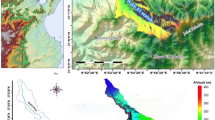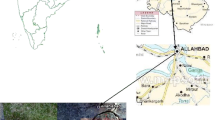Abstract
Soil loss by water erosion is a common type of land degradation issue in the hilly regions of the world. The present study investigates the soil erosion risk due to change in Land Use Land Cover (LULC) brought in by the construction of dam in a hilly watershed of the River Urmodi embracing Kaas Plateau, a world heritage site. The Revised Universal Soil Loss Equation (RUSLE) model was used with change detection analysis for soil erosion estimation. Thematic layers required for the computation of factors required in RUSLE were gathered using remote sensing (RS) and Geographical Information Science techniques. The changes in LULC affect the soil erosion phenomena and therefore, the present study analyzes drastic alteration in the hydrological nature of the watershed brought by the construction of reservoir through damming the Urmodi River. For assessment of the impact of the dam we have used RS data with 30 m spatial resolution, which includes Digital Elevation Model and Landsat TM and Landsat 8 bands. Using RUSLE, soil risk zone was mapped and the Change Detection in zones were computed. The very simple logic of ‘soil erosion class as a type of land cover’ was successfully applied to perform the change transition for the Urmodi river watershed. Confusion matrix technique used for analyzing the change, has the ability to show the previous and next condition of zone type very affectively with good precision. Along with Change Detection technique, soil erosion class transition operation was also performed to assess the conversion of zones. This gave the important output regarding increased conversion from very slight to very severe risk zone by 70.22 km2. The investigation concludes that there was extensive change in very severe (> 80 ton ha−1 year−1) soil vulnerable risk zone in the last 17 years with the rise of 14.87%. The conversion of lower risk category areas to higher risk category areas of soil erosion was detected all over the watershed. Undertaking such studies revealed the changes brought in the soil erosion susceptible zones by building of dams. This study will be a crucial help to policy and decision makers for proper planning of watershed with consideration to LULC in the event of dam construction on the rivers flowing in hilly terrain.







Similar content being viewed by others
References
Bayramov E, Schlager P, Kada M et al (2019) Quantitative assessment of climate change impacts onto predicted erosion risks and their spatial distribution within the landcover classes of the Southern Caucasus using GIS and remote sensing. Model Earth Syst Environ 5:659–667. https://doi.org/10.1007/s40808-018-0557-3
Conrad O, Bechtel B, Bock M et al (2015) System for automated geoscientific analyses (SAGA) v. 2.1.4. Geosci Model Dev 8:1991–2007. https://doi.org/10.5194/gmd-8-1991-2015
Dissanayake D, Morimoto T, Ranagalage M (2019) Accessing the soil erosion rate based on RUSLE model for sustainable land use management: a case study of the Kotmale watershed, Sri Lanka. Model Earth Syst Environ 5:291–306. https://doi.org/10.1007/s40808-018-0534-x
Fagnano M, Diodato N, Alberico I, Fiorentino N (2012) An overview of soil erosion modelling compatible with RUSLE approach. Rend Lincei 23:69–80. https://doi.org/10.1007/s12210-011-0159-8
FAO (Food and Agriculture Organization) (2011) The state of the world’s land and water resources for food and agriculture. World Bank, Washington, DC
FAO (2016) India country programming framework 2016–2017. http://www.fao.org/fileadmin/user_upload/FAOcountries/India/docs/INDIA_FAO_Country_Programming_Framework_2016_%E2%80%93_2017.pdf
Gashaw T, Tulu T, Argaw M (2017) Erosion risk assessment for prioritization of conservation measures in Geleda watershed, Blue Nile basin, Ethiopia. Environ Syst Res. https://doi.org/10.1186/s40068-016-0078-x
Govt. of India WRIS (2017) India-WRIS Wiki. http://www.india-wris.nrsc.gov.in/wrpinfo/index.php?title=Urmodi_Major_Irrigation_Project_JI00494. Accessed Jan 2017
Govt. of Maharashtra (2017) Satara district official website. http://satara.nic.in. Accessed 20 Aug 2017
Hu Y, Tian G, Mayer AL, He R (2015) Risk assessment of soil erosion by application of remote sensing and GIS in Yanshan Reservoir catchment, China. Nat Hazards 79:277–289. https://doi.org/10.1007/s11069-015-1841-4
Ismail J, Ravichandran S (2006) RUSLE2 model application for soil erosion assessment using remote sensing and GIS. Water Resour Manag 22:83–102. https://doi.org/10.1007/s11269-006-9145-9
IUCN (2012) IUCN evaluations of nominations of natural and mixed properties to the world heritage list (WHC-12/36.COM/INF.8B2)
Jain MK, Das D (2010) Estimation of sediment yield and areas of soil erosion and deposition for watershed prioritization using GIS and remote sensing. Water Resour Manag 24:2091–2112. https://doi.org/10.1007/s11269-009-9540-0
Jasrotia AS, Singh R (2006) Modeling runoff and soil erosion in a catchment area, using the GIS, in the Himalayan region, India. Environ Geol 51:29–37. https://doi.org/10.1007/s00254-006-0301-6
Jiang L, Yao Z, Liu Z et al (2015) Estimation of soil erosion in some sections of Lower Jinsha River based on RUSLE. Nat Hazards 76:1831–1847. https://doi.org/10.1007/s11069-014-1569-6
Jordan G, Van Rompaey A, Szilassi P et al (2005) Historical land use changes and their impact on sediment fluxes in the Balaton basin (Hungary). Agric Ecosyst Environ 108:119–133. https://doi.org/10.1016/j.agee.2005.01.013
Kavian A, Hoseinpoor Sabet S, Solaimani K, Jafari B (2015) Simulating the effects of land use changes on soil erosion using RUSLE model. Geocarto Int 6049:1–40. https://doi.org/10.1080/10106049.2015.1130083
Kumar S, Gupta S (2016) Geospatial approach in mapping soil erodibility using CartoDEM—a case study in hilly watershed of Lower Himalayan Range. J Earth Syst Sci 125:1463–1472. https://doi.org/10.1007/s12040-016-0738-2
Kumar A, Devi M, Deshmukh B (2014) Integrated remote sensing and geographic information system based RUSLE modelling for estimation of soil loss in western Himalaya, India. Water Resour Manag 28:3307–3317. https://doi.org/10.1007/s11269-014-0680-5
Li X, Niu X, Wang B et al (2016) Driving forces of dynamic changes in soil erosion in the Dahei Mountain ecological restoration area of northern China based on GIS and RS. PLoS One 11:1–15. https://doi.org/10.1371/journal.pone.0142331
Magesh NS, Chandrasekar N (2016) Assessment of soil erosion and sediment yield in the Tamiraparani sub-basin, South India, using an automated RUSLE-SY model. Environ Earth Sci 75:1208. https://doi.org/10.1007/s12665-016-6010-x
Markose VJ, Jayappa KS (2016) Soil loss estimation and prioritization of sub-watersheds of Kali River basin, Karnataka, India, using RUSLE and GIS. Environ Monit Assess 188:225. https://doi.org/10.1007/s10661-016-5218-2
Muralikrishnan S, Pillai A, Narender B et al (2013) Validation of Indian national DEM from Cartosat-1 data. J Indian Soc Remote Sens 41:1–13. https://doi.org/10.1007/s12524-012-0212-9
Mushtaq F, Lala MGN (2017) Assessment of hydrological response as a function of LULC change and climatic variability in the catchment of the Wular Lake, J&K, using geospatial technique. Environ Earth Sci. https://doi.org/10.1007/s12665-017-7065-z
Nag S, Roy MB, Roy PK (2020) Optimum prioritisation of sub-watersheds based on erosion-susceptible zones through modeling and GIS techniques. Model Earth Syst Environ 6:1529–1544. https://doi.org/10.1007/s40808-020-00768-z
Naqvi HR, Mallick J, Devi LM, Siddiqui MA (2013) Multi-temporal annual soil loss risk mapping employing Revised Universal Soil Loss Equation (RUSLE) model in Nun Nadi Watershed, Uttrakhand (India). Arab J Geosci 6:4045–4056. https://doi.org/10.1007/s12517-012-0661-z
Oldeman LR (1994) The global extent of soil degradation. In: Greenland DJ, Szabolcs I (eds) Soil resilience and sustainable land use. CAB International, Wallingford, pp 99–118
Pandey A, Chowdary VM, Mal BC (2007) Identification of critical erosion prone areas in the small agricultural watershed using USLE, GIS and remote sensing. Water Resour Manag 21:729–746. https://doi.org/10.1007/s11269-006-9061-z
Parveen R, Kumar U (2012) Integrated approach of universal soil loss equation (USLE) and geographical information system (GIS) for soil loss risk assessment in Upper South Koel Basin, Jharkhand. J Geogr Inf Syst 04:588–596. https://doi.org/10.4236/jgis.2012.46061
Prasannakumar V, Vijith H, Geetha N, Shiny R (2011) Regional scale erosion assessment of a sub-tropical highland segment in the Western Ghats of Kerala, South India. Water Resour Manag 25:3715–3727. https://doi.org/10.1007/s11269-011-9878-y
Renard KG, Foster GR, Weesies GA et al (1997) Predicting soil erosion by water: a guide to conservation planning with the revised universal soil loss equation (RUSLE). Agriculture Handbook No. 703. Agric. Handb
Renard KG, Yoder DC, Lightle DT, Dabney SM (2011) Universal soil loss equation and revised universal soil loss equation. In: Handbook of erosion modelling. John Wiley & Sons Ltd, Chichester, pp 135–167
Semwal P, Khobragade SD, Nainwal HC (2017) Modelling of recent erosion rates in a lake catchment in the North-Western Siwalik Himalayas. Environ Process 4:355–374. https://doi.org/10.1007/s40710-017-0234-y
Shalaby A, Tateishi R (2007) Remote sensing and GIS for mapping and monitoring land cover and land-use changes in the Northwestern coastal zone of Egypt. Appl Geogr 27:28–41. https://doi.org/10.1016/j.apgeog.2006.09.004
Singh G, Chandra SBR (1981) Soil loss prediction research in India. CSWCRTI bulletin no. T-12/D9. Dehradun, India
Stone RP, Hilborn D (2012) Universal soil loss equation (USLE) factsheet. Ministry of Agriculture, Food and Rural Affairs, Ontario
Tang Q, Xu Y, Bennett SJ, Li Y (2015) Assessment of soil erosion using RUSLE and GIS: a case study of the Yangou watershed in the Loess Plateau, China. Environ Earth Sci 73:1715–1724. https://doi.org/10.1007/s12665-014-3523-z
Tilahun AK, Haregeweyn N, Pingale SM (2018) Landscape changes and its consequences on soil erosion in Baro river basin, Ethiopia. Model Earth Syst Environ 4:793–803. https://doi.org/10.1007/s40808-018-0466-5
Van Der Knijff JM, Jones RJA, Montanarella L (1999) Soil erosion risk assessment in Europe. Luxemb Off Publ Eur Communities EUR 19022:32
Walkley A, Black IA (1934) An examination of the Degtjareff method for determining organic carbon in soils: effect of variation in digestion conditions and of inorganic soil constituents. Soil Sci 63:251–263. https://doi.org/10.1097/00010694-194704000-00001
Wischmeier WH, Smith DD (1978) Predicting rainfall erosion losses: a guide to conservation planning. US Dep Agric Handb No. 537, pp 1–69. https://doi.org/10.1029/TR039i002p00285
Acknowledgements
The first author is thankful to School of Earth Sciences, Punyashlok Ahilyadevi Holkar Solapur University, Solapur (formerly Solapur University, Solapur) for providing Departmental Research Fellowship for the current study. We are also thankful Earth Explorer (https://earthexplorer.usgs.gov) portal for providing Landsat 8 OLI/TIRS, SRTM DEM data. Also, we would like to thank Bhuvan portal (https://bhuvan.nrsc.gov.in) for availing Cartosat DEM data and India Meteorological Department (IMD), Pune for providing rainfall data at given weather stations.
Author information
Authors and Affiliations
Corresponding author
Ethics declarations
Conflict of interest
Authors have no conflict of interest.
Additional information
Publisher's Note
Springer Nature remains neutral with regard to jurisdictional claims in published maps and institutional affiliations.
Rights and permissions
About this article
Cite this article
Bagwan, W.A., Gavali, R.S. Delineating changes in soil erosion risk zones using RUSLE model based on confusion matrix for the Urmodi river watershed, Maharashtra, India. Model. Earth Syst. Environ. 7, 2113–2126 (2021). https://doi.org/10.1007/s40808-020-00965-w
Received:
Accepted:
Published:
Issue Date:
DOI: https://doi.org/10.1007/s40808-020-00965-w




